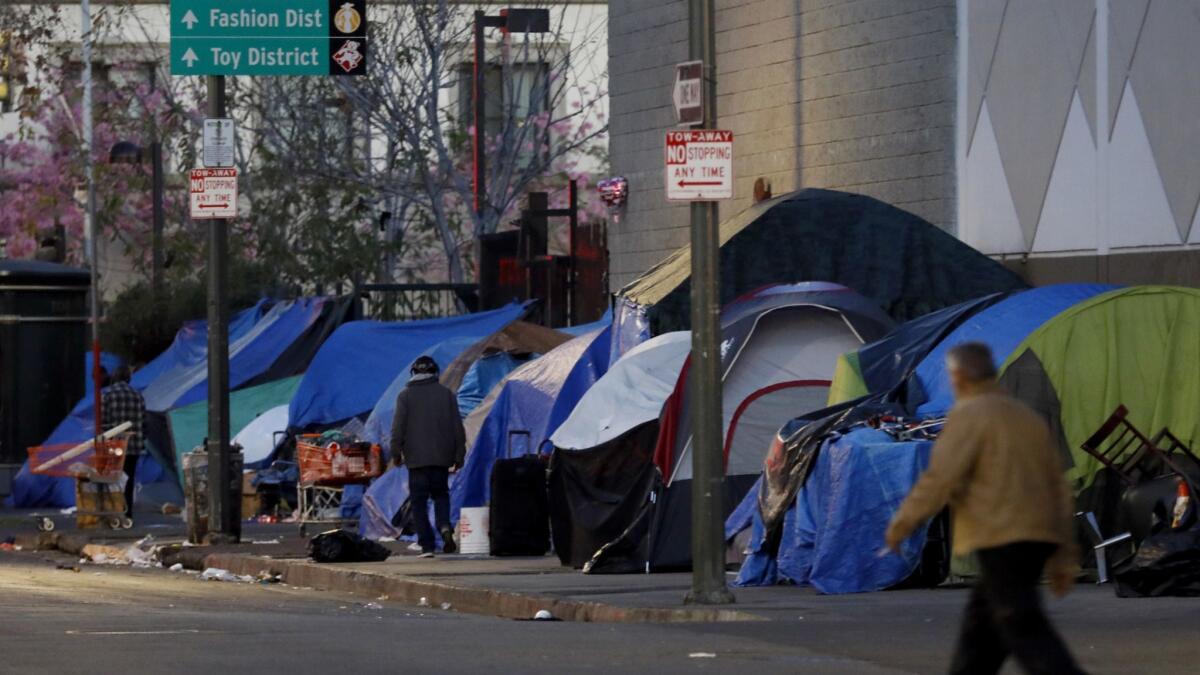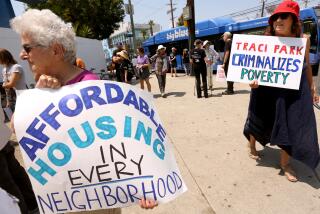California has the most homeless people of any state. But L.A. is still a national model

WASHINGTON — With tens of thousands of homeless people living on the streets, Los Angeles officials have increasingly found themselves as the subject of criticism for what many Angelenos see as a failure to keep up with a problem that seems to be getting worse.
But across the country, L.A. isn’t considered to be a failure. To the contrary, at last week’s National Conference on Ending Homelessness in Washington, D.C., attendees repeatedly held up the city, the county and the state as models of political will for getting people into housing.
“I think there’s actually incredibly strong things happening across California,” said Matthew Doherty, executive director of the United States Interagency Council on Homelessness. “In Los Angeles, there are some of the best permanent supportive housing providers in the country, with some of the most innovative projects, engagement of the public health system directly in the work of homelessness, the city-county partnership... There’s a lot that’s going on there.”
The confab attracted more than 2,000 homeless advocates, outreach workers and many others working in a well air-conditioned hotel to stem the tide of homelessness. They attended sessions that included research on unsheltered people and how to build permanent supportive housing quickly. Some also went to Capitol Hill to meet with members of Congress.
Although Los Angeles wasn’t mentioned in most sessions, the state’s swelling crisis was a constant presence for many attendees. L.A., like much of California, served as a cautionary tale for what they didn’t want their cities to become and a place from where they could learn how to get people off the streets and into housing, according to more than a dozen people who spoke with The Times.
In Seattle, for example, officials are looking to replicate the city-county set up of the Los Angeles Homeless Services Authority as they contemplate how to cooperate across jurisdictions.
California accounts for most of the country’s homeless population, and it’s growing. In 2018, there were 129,972 people on the streets on any given night statewide. The most recent count conducted in Los Angeles County revealed that there were nearly 59,000 homeless people in 2019, while there were 9,784 homeless people in San Francisco, including in jails, hospitals and rehab centers — a jump of 30% from 2017.
But officials from other urban areas told The Times they are taking cues from Los Angeles and San Francisco, and, as a result, are making progress in reducing their homeless populations.
In 2018, for example, there were 552,830 homeless people across the United States, a dramatic decrease from 2008 when there were 639,784, according to the National Alliance to End Homelessness, which hosted last week’s conference.
Still, the numbers have begun to tick up again over the last few years — occurring against the backdrop of a broader, national discussion about affordable housing — and officials worry the trend will continue.
“I think that there are times where the rest of the country is a little bit jealous of the amount of money that seems to be in L.A.,” saidIain De Jong, a consultant who helps cities formulate plans to address homelessness. “One of the things that you’ll hear in other communities is sentiments like, ‘Well, if we had even a fraction of that money or if we could figure out how to get a fraction of our sales tax, our world would be wonderful.’”
Several conference attendees speculated that a booming economy has exacerbated California’s problems — hints of which they had noticed in their own states.
Southern Nevada, which includes Las Vegas, has a homeless population that has declined over the last two years. But as a region reliant on tourism, with a growing population and a lack of affordable housing, there are similarities to Los Angeles.
Michele Fuller-Hallauer, who runs homeless services for three counties in the state, said she regularly calls her counterparts in Los Angeles and San Francisco to get their advice on several matters, such as how best to set up shelters that can help people get off the streets and then quickly get those people into housing.
She said her colleagues in San Francisco have been a huge help in understanding the specifics of how governments do master leasing for buildings and how to set up navigation centers to help homeless people find housing.
“California has been dealing with that for quite a while. It’s fairly new to us,” Fuller-Hallauer said. “So it’s kind of alarming that we’re now there and seeing the crisis that is taking place in L.A., San Francisco [and] Alameda County. We’re fearful that, you know, we’re going to be there real quick.”
On the other side of the country, Jacksonville, Fla., has seen a 9% decrease in the homeless population and the number of homeless veterans has dropped dramatically.
Dawn Gilman, who runs homeless services for three counties that include and surround that city, said she is amazed by the scale of the challenges in the Golden State. Her region is on the opposite end of the 10 Freeway from Los Angeles, and it includes a port, a vibrant urban area and an unsheltered population that frustrates residents.
“We’re about 1.2 million [people]. So when I go to Los Angeles, I just divide everything by 10,” Gilman said. “If you can solve homelessness in New York, California, Texas and Florida, homelessness looks different across the country at that point.”
Conference attendees complained that a lack of federal action has made it more difficult for them to confront the swelling numbers of people on American streets and solve the swirl of factors that are driving vulnerable Americans there.
The White House has shown little substantive interest in fighting homelessness. President Trump recently referred to California on Fox News calling it “disgraceful” and falsely stating that this was something that began recently.
“It’s a phenomenon that started two years ago. It’s very disgraceful,” he said. “We’re looking at it very seriously.”
Despite little action from the executive branch, some in Congress say they recognize that big dollars are necessary to make progress on homelessness.
Rep. Maxine Waters (D-Los Angeles), who is the chair of the House Financial Services Committee, recently introduced a bill that would allot nearly $14 billion for programs to help get people off the streets. About $5 billion would go to support the building of homeless shelters, while much of the rest would go to funding more housing for poor people.
Despite dozens of co-sponsors who have decried homelessness in their districts, this legislation has gone nowhere. The full, Democratic-controlled House hasn’t voted on it, and it lacks a companion bill in the Senate.
“There’s a lot of talk and people, you know, say, ‘What a shame. It’s unconscionable. How could this happen in America? It’s all over the country,’” Waters said. “But then when it comes down to, you know, whether or not we’re going to commit the real dollars that are needed to deal with homelessness,” nothing happens.
As the last budget deal was being hashed out, Waters said she pushed House Speaker Nancy Pelosi (D-San Francisco) to have homelessness be a top-line issue that benefits from the increase in domestic spending.
“We had a significant number of signatures, but then when I brought it up in the caucus as we talked about the appropriations [bill], and I wanted to make it one of our focus points in our agenda, I didn’t get a lot of support for it.”
Despite the progress so many communities across the country are making, the scale of the challenge in California is still viewed with trepidation. At the end of the day, even getting a small number of people off the streets still feels like a huge task, said Fuller-Hallauer, who manages a region of Nevada with about 5,300 homeless people on a given night.
“If we can’t develop enough affordable housing, if rents keep going up, it’s very realistic that we could end up in that same crisis [as California,]” she said. “We hopefully don’t ever have to be at that level because our space feels daunting to us.”
More to Read
Sign up for Essential California
The most important California stories and recommendations in your inbox every morning.
You may occasionally receive promotional content from the Los Angeles Times.











